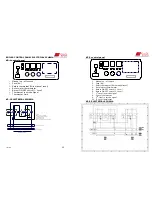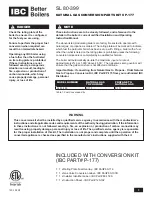
erensan
°
“
The Heating Engineer
”
06042007
25
HEATING SYSTEM ADJUSTMENTS:
The boiler circulation pump should be checked for proper selection and
adjustment.
a- Pump flow should be calculated with the formula below:
Q
p:
Pump flow rate.
Q
p:
Q
k
/[C
p
*(t
g
-t
d
)] : [lt/h].
Q
k:
Boiler output [kcal/h]
C
p:
Specific heat capacity of water [1 kcal/(kg.°C)]
∆
T is taken as tg-td=20 °C (in 90/70
0
C system)
b-Pump pressure;
H
p
:[mWC] Should be greater than the calculated critical circuit pressure
loss of the building circuit.
The pump selection should be approved by the (Mech. Eng.) responsible
for the building project and the technical application. Where a project
and calculations do not exist or are not available, regulations can be
made by placing thermometers, one each, on the boiler outflow and
return lines, a manometer to the circulation pump exit and by
adjustments with the help of the related pump curve, through the
circulation pump valves so that the water temperature difference
between outflow and return lines is 20
0
C. In the case of big pump
selection, the outflow-return temperature difference will stay below 20
o
C and boiler outflow temperature may not rise, and in the case of small
pump selection, the outflow return temperature difference will be over
20
0
C and the high and remote radiators may not function efficiently
enough.
Every morning, the water level and pressure should be controlled from
the hydrometer or manometer in the heating system. If it is below the
normal value, water should be added while the boiler is cool. If it is a
closed expansion system, the closed expansion tank gas pressure should
be controlled to be equal to the static water height of the building. This
control should be done on the expansion tank manometer if it is present,
if not, it should be done from the gas side valve with a manometer.
erensan
°
“
The Heating Engineer
”
06042007
26
If the pressure is excessive, it should be discharged from the related
valve, if it is insufficient, nitrogen gas should be added by the expansion
tank authorized service.
If water comes out from the valve during the check instead of gas or air,
this means the tank diaphragm is torn and it should be changed by
contacting an authorized service.
DISCHARGE OF BOILER WATER
•
After a season’s utilization, the boilers should be cleared of gasket
remains, mud and residue in the heating system.
•
The blind flanges at the lowest level of the main distribution and
collection reservoir and boiler filling-discharge tap are opened, and the
system and boiler water is rapidly flushed out.
•
After cleaning the system should be filled with water (as described the
article
filling the system with water
).
•
The boiler water should not be discharged at any time except pre-
operation cleaning and water should not be added to the boiler except
for the purpose of compensating any depletion in the expansion tank.
TAKING BOILER OUT OF OPERATION
The taking of boiler out of operation should be as follows:
•
The burner is stopped and boiler surfaces are cooled.
•
The soot and smut in the boiler (the cover, smoke chest and the
smoke pipes) should be cleaned.
•
The cleaned surfaces should be checked under strong light to detect
damages like leakages, oozing, cracks, etc. If such damages exist, the
authorized services are notified and the necessary repairs are done.





































